Introduction
Sunset canvas painting is a captivating way to express creativity and artistic flair. The vibrant colors and serene imagery of sunsets inspire many artists, from beginners to seasoned professionals. In this article, we will explore various sunset canvas painting ideas, techniques, and tips to help you unleash your inner artist. By the end, you’ll be excited to create your own stunning sunset scenes on canvas!
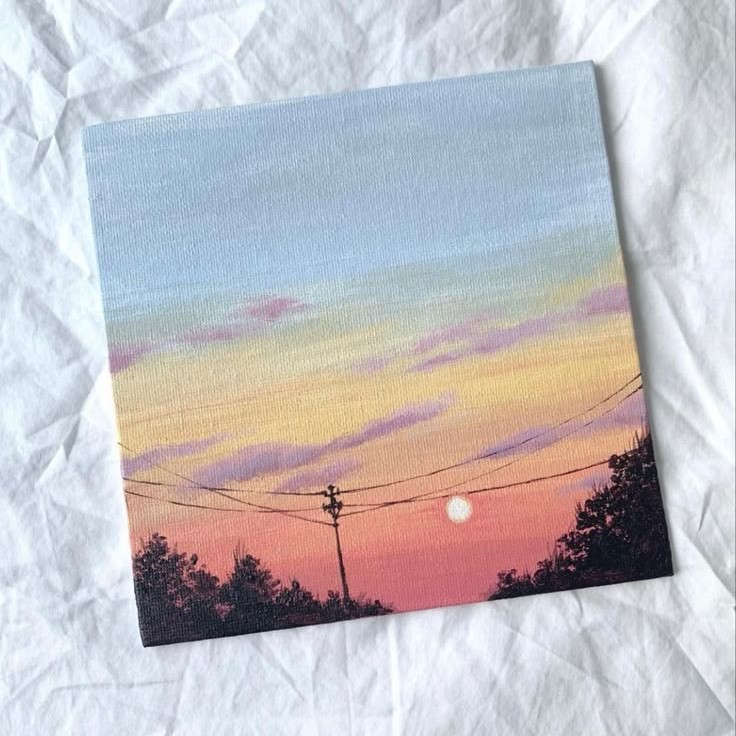
The appeal of sunset paintings lies in their ability to evoke emotions and memories. Whether you want to capture the tranquility of a peaceful evening or the dynamic hues of a fiery horizon, mastering sunset paintings can enhance any art collection or home decor.
Choosing the Right Materials for Sunset Painting
Creating a beautiful sunset canvas begins with choosing the right materials. The quality of your tools impacts your painting’s outcome.
Selecting Quality Canvas
Select a durable, stretched canvas for your sunset painting. Stretched canvases provide a steady surface and are easy to work on. Look for acid-free options to ensure your art lasts a long time. Pre-primed canvases with gesso can save preparation time. Alternatively, you can prime the canvas yourself to control texture.
Canvas boards are a more affordable option for beginners. They are lightweight and portable, ideal for practice. Paper can also be used but may warp under paint layers unless it’s high-quality.
Best Paint Types for Sunset Colors
Choose paints that capture the warm glow of sunsets. Acrylic paints are popular for their quick drying time and vibrant colors. They are versatile, allowing for layering and blending to achieve gradient effects easily.
Oil paints are another great choice, offering rich pigments and smooth blending. They dry slower, giving you more time to create intricate details. For beginners, watercolor paints can be used to achieve soft and transparent effects but require special techniques.
Look for pigments specifically labeled as “sunset colors” or “warm tones.” Combining reds, oranges, yellows, and purples helps create a realistic sunset atmosphere. High-quality paints with strong pigmentation result in clearer, long-lasting art.
Using the right materials will make capturing the magic of a sunset on canvas much easier!
Techniques for Capturing Sunset on Canvas
Creating a stunning sunset painting requires mastering key techniques for depth and realism.
Layering Paint for Gradient Effects
Layering paint helps create smooth transitions in your sunset. Start with the lightest colors, like soft yellows and oranges, at the horizon. Gradually add warmer tones, such as reds and deep purples, as you move higher on the canvas. Blend the colors while they are still wet to achieve a seamless gradient effect.
Work in thin layers for more control over blending. Use a dry brush or sponge to soften edges. Avoid overworking the paint to maintain clarity in your hues. For best results, allow each layer to dry before adding the next, especially with acrylics or oils.
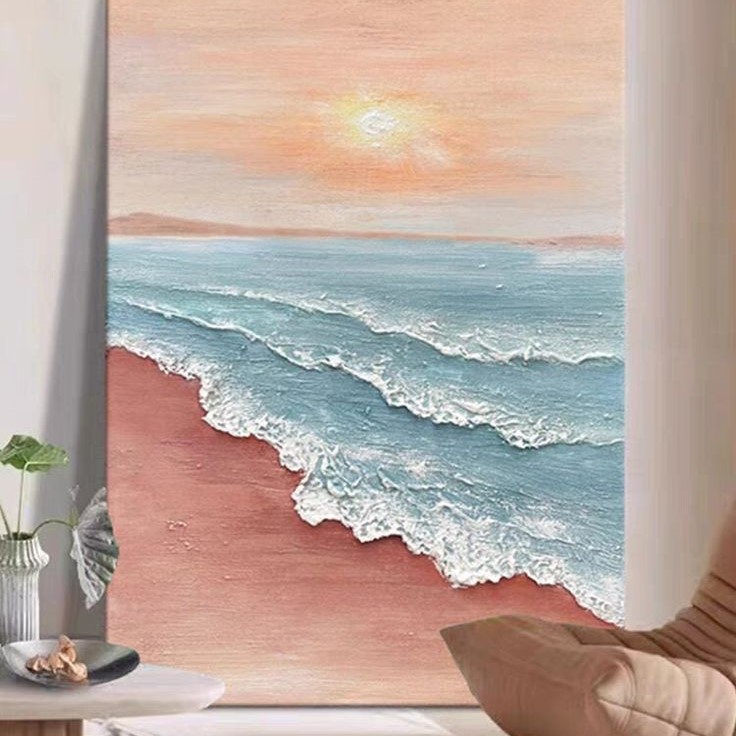
Using Brushes to Create Realistic Sunlight
Brush selection is essential for crafting realistic sunlight. Use a flat or fan brush to mimic rays of light. Choose soft, synthetic brushes for smooth blending, especially when creating the glowing effect of the sun.
Use quick, light strokes to depict sunrays. Add white or pale yellow highlights around the sun to enhance brightness. Thin, round brushes work great for adding fine details, such as reflections or subtle lines of light on water or clouds.
Experiment with dry brushing to create texture. This technique is ideal for painting glowing edges on clouds or subtle light effects in the sky. By combining brush variety and detailed strokes, you can bring your sunset canvas painting to life.
Color Schemes for Sunset Painting
Choosing the right color scheme is essential for creating stunning sunset canvas paintings. Your palette sets the mood and makes your artwork captivating. Two popular categories to explore are warm tones for dramatic sunsets and cool tones for serene evening skies.
Warm Tones for a Dramatic Sunset
Warm colors create vibrant, eye-catching sunsets. Reds, oranges, and yellows are essential for this palette. Start with pale yellows near the horizon to mimic the sun’s glow. Gradually blend into deep oranges and bold reds as you move upward. Add hints of purple or crimson at the top for extra depth.
Use high-quality paints labeled as “sunset colors” for rich, saturated hues. Experiment with blending warm colors in thin layers. This approach enhances the gradient effect and makes the sky look alive. Warm tones work well for sunsets over deserts, beaches, or tropical scenes.
Cool Tones for a Serene Evening Sky
Cool tones convey calmness and tranquility in sunset paintings. Blues, purples, and soft pinks dominate this palette. Begin with pale peach or soft lavender at the horizon. Blend into light blues and cooler purples as you move to the top of the canvas.
Cool tones are ideal for portraying the peaceful atmosphere of twilight skies. Highlight areas with light pastel shades to create a gentle glow. These colors are perfect for painting mountain sunsets or reflections over still lakes. Use fine brushes for smooth transitions between shades and soft, dreamy effects.
Combining warm and cool tones can add dimension to your sunset canvas painting. Proper color selection ensures your artwork sets the desired mood and leaves a lasting impression.
Popular Themes for Sunset Paintings
Sunsets evoke strong emotions and offer endless possibilities for artistic inspiration. Exploring popular themes for sunset canvas paintings can make your artwork even more captivating. Two timeless and compelling themes are ocean and beach sunsets, and serene mountain sunset scenes.
Ocean and Beach Sunsets
Ocean and beach sunsets are among the most admired themes in sunset paintings. The vast expanse of water creates a natural mirror, reflecting the vibrant hues of the sunset. Start with warm colors like soft yellows and oranges near the horizon. Gradually blend into richer reds and purples as you move upward.
Incorporate details like gentle waves, sandy beaches, or palm trees for added interest. Use fine brushes to depict reflections and subtle light effects on the water’s surface. Consider adding silhouettes of boats or people for depth and storytelling. This theme works well for creating relaxing, tropical vibes.
Mountain Sunset Scenes
Mountain sunsets focus on the dramatic interplay between the setting sun and rugged peaks. Begin by laying down soft pinks and purples near the mountain edges. Use cooler tones like blues and deep purples to capture the fading daylight.
Add highlights to the mountain tops to mimic the golden glow of sunlight. Use dark tones for shadowed areas to enhance depth. Fine details, such as trees or wildlife, can make the scene feel alive. Mountain sunset themes often convey peace and can highlight nature’s grandeur.
Both themes allow you to experiment with color, light, and contrast. Choose the one that resonates best with your creative vision.
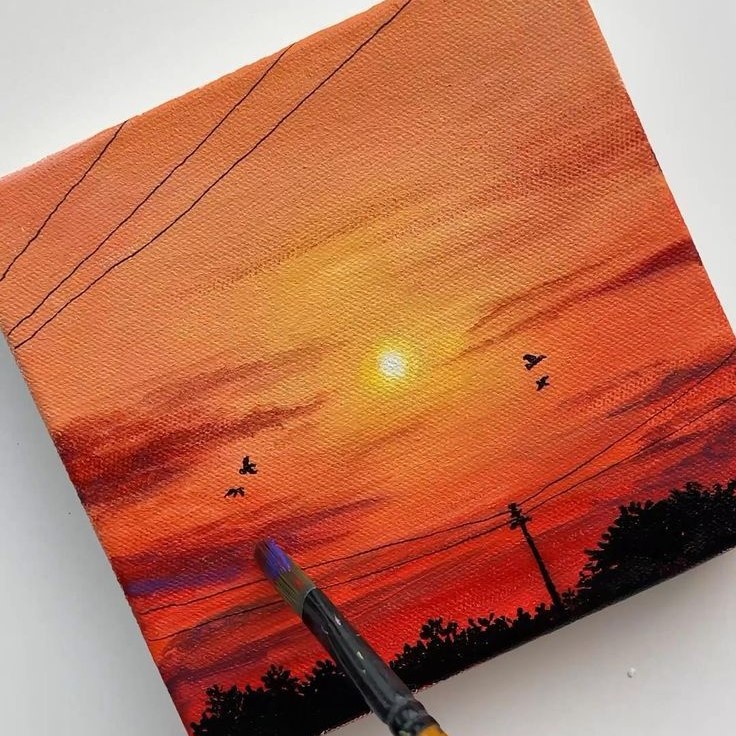
Tips for Beginner Sunset Painting
Creating a sunset canvas is a great starting point for beginners. Simplify your approach by focusing on composition and easy-to-follow steps.
Simple Sunset Composition Ideas
Start with a basic layout to make your painting manageable and enjoyable:
Open Sky with Horizon
- Gradient Sky: Begin by creating a gradient sky that captures the transition of colors from day to night. Incorporate shades of blue, pink, orange, and purple to depict the beauty of a sunset.
- Warm Color Blending: Focus on softly blended warm colors near the horizon. Use techniques like wet-on-wet blending to achieve smooth transitions that mimic the natural gradation observed during sunsets.
- Visible Sun: Ensure to include a visible sun in your painting. Position it strategically on the horizon, using bright yellows or whites to create a focal point that draws the viewer’s eye.
- Simple Color Transitions: Aim for simple color transitions from light to dark, avoiding harsh lines. This approach creates a serene atmosphere, enhancing the overall beauty of the sky.
Silhouettes
- Adding Depth: Include easy silhouettes, such as trees, hills, or birds, to add depth to your artwork. These elements create a sense of perspective against the expansive sky.
- Tree Shapes: For trees, consider varied shapes and sizes to represent different species. Use dark colors like black or deep brown for a striking contrast against the vibrant background.
- Hills and Mountains: Incorporate rolling hills or distant mountains as silhouettes. Their varying heights will add interest and dimension to the landscape.
- Birds in Flight: Add a few simple shapes for birds flying across the sky. This additional detail enhances the storytelling aspect of your painting and creates a feeling of movement.
Water Reflection
- Ocean View: Paint an ocean view that captures the dynamic beauty of a sunset reflecting on water. The waves can add a sense of motion while mirroring the colors in the sky.
- Reflected Sunset Colors: Use the same warm colors from the sunset to depict reflections in the water. Blues can flow into oranges, pinks, and purples, creating a harmonious visual effect.
- Dynamic, Mirrored Effect: Focus on blending the reflected colors seamlessly, allowing for a mirrored effect that suggests tranquility and depth. This dynamic quality can elevate the overall piece.
- Gentle Waves: Incorporate gentle waves or ripples to add texture to the water, enhancing the feeling of realism and movement within the scene.
Mountain Shadows
- Depicting Mountains: Use darker tones to illustrate mountains that stand against the fading light of the sunset. This contrast emphasizes the time of day and the transition from light to shadow.
- Shades for Depth: Opt for deep blues, grays, or blacks to provide definition to the mountains. These darker hues allow the lighter colors of the sunset to pop and draw attention.
- Layered Effect: Create a layered effect by painting multiple mountain ranges in varying shades. This technique adds depth and interest to your composition.
- Fading Light: Highlight the fading light on the peaks, using subtle lighter shades to depict areas where the last light catches the mountain tops. This element emphasizes the transition into evening.
For each composition, plan your design lightly with pencil or chalk before using paint. Keep shapes basic and focus on smooth blending.
Step-by-Step Sunset Painting Guide
Follow these easy steps to bring your sunset canvas painting to life:
- Prepare Your Materials: Use a primed canvas, quality paints, and brushes suited for blending. Acrylic paint is ideal for beginners.
- Start with the Base Colors: Lay down the foundation using pale yellows and oranges near the horizon.
- Build the Gradient: Gradually transition to deeper oranges and reds, blending while the paint is wet.
- Add Cool Tones: Incorporate purples and blues higher up for realism, blending softly for balance.
- Highlight the Sun: Use vibrant whites or pale yellows to make the sun stand out. Light strokes work best.
- Include Silhouettes or Details: Paint simple shapes like mountains or palm trees in shadow form using black or dark tones.
- Focus on Final Touches: Smooth transitions, soften edges, and refine any areas needing extra detail. Allow the paint to dry.
With patience and practice, beginners can create stunning sunset paintings easily. Start simple and enjoy the process.
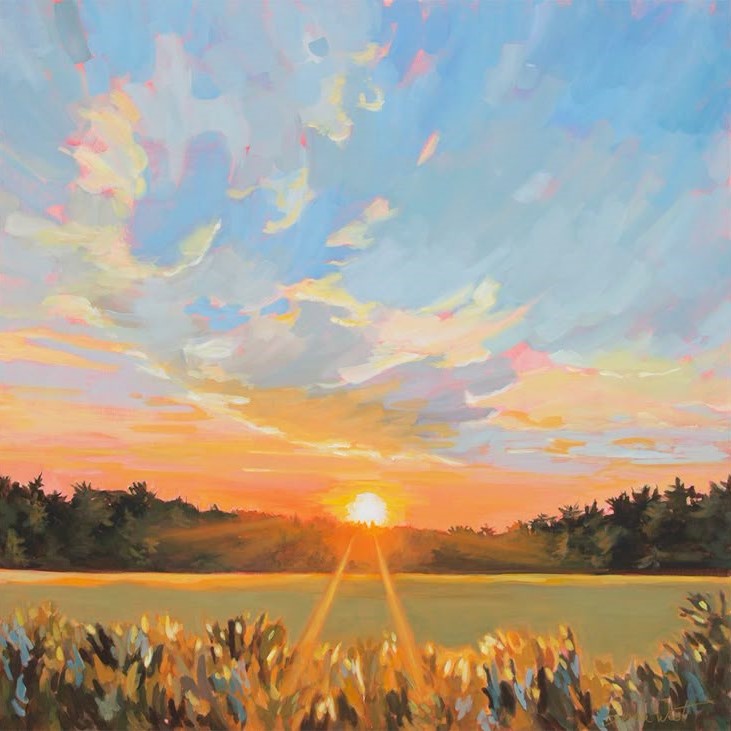
Adding Personal Touches to Your Sunset Painting
Creating a sunset canvas is an opportunity to showcase your personal style. Adding unique elements can make your painting stand out and reflect your creativity.
Incorporating Unique Landscapes
Include distinctive landscapes to personalize your sunset painting. Think about places that inspire you, like a favorite hiking trail or a peaceful lookout. Add features such as specific mountain ranges, unusual rock formations, or recognizable landmarks.
If painting an ocean sunset, experiment with uncommon details. Include shells, driftwood, or reflections of unique objects, like an old pier. For rural settings, add cozy details like rustic barns, fences, or blooming fields.
Use reference photos to depict locations accurately. Simplify complex elements into basic shapes for a cleaner design. Adding unique landscapes can transform your painting into a one-of-a-kind masterpiece.
Blending Abstract Elements with Sunset Colors
Mix abstract designs with vibrant sunset hues for a modern and creative touch. Use bold brush strokes to form swirling skies or geometric patterns in the clouds. Experiment with layering colors to create rich textures and unexpected gradients.
Add abstract features such as glowing lines or playful shapes that contrast with traditional landscape elements. Incorporate metallic or iridescent paints to give your canvas a dynamic, shimmering effect.
Use a palette knife or sponges to produce striking textures. Abstract designs allow you to break free from realism and embrace artistic freedom while maintaining the allure of sunset tones.
Display and Preservation of Sunset Canvas Art
To ensure your sunset canvas art remains stunning over time, proper display and care are essential.
Framing Options for Sunset Paintings
Framing enhances your painting while protecting it from wear and tear. Choose a frame that complements your artwork’s theme. Wooden frames add warmth and match natural scenes like mountains or beaches. Black or metallic frames work well for modern or abstract designs.
When selecting a frame, ensure it won’t obstruct the painting’s edges or colors. Opt for acid-free backing and UV-protective glass to shield the painting from fading. Floating frames are ideal for a gallery-style look, offering a modern touch.
For larger works, consider a sturdy frame to prevent sagging. Lightweight frames are better for smaller paintings. Explore different frame styles to find the one that suits your sunset canvas best.
Protecting Your Artwork from Damage
Proper preservation keeps your painting in excellent condition for years. Display your sunset canvas in places safe from direct sunlight and moisture. Prolonged exposure to UV light can cause fading, while humidity may damage the canvas.
Dust your painting regularly using a soft, dry cloth. Avoid harsh chemicals that can degrade paints or canvas. If framed, clean the glass gently to maintain clarity without damaging the frame.
Store unused art in a cool, dry area, preferably wrapped in acid-free paper. For oil paintings, ensure the surface dries fully before framing or storing. Acrylic paintings are more durable but still need proper care.
Consider applying a protective varnish to seal the paint and prevent cracking. Choose varnishes designed for your paint type, such as oil or acrylic. Following these steps will keep your sunset canvas vibrant and safe for generations.
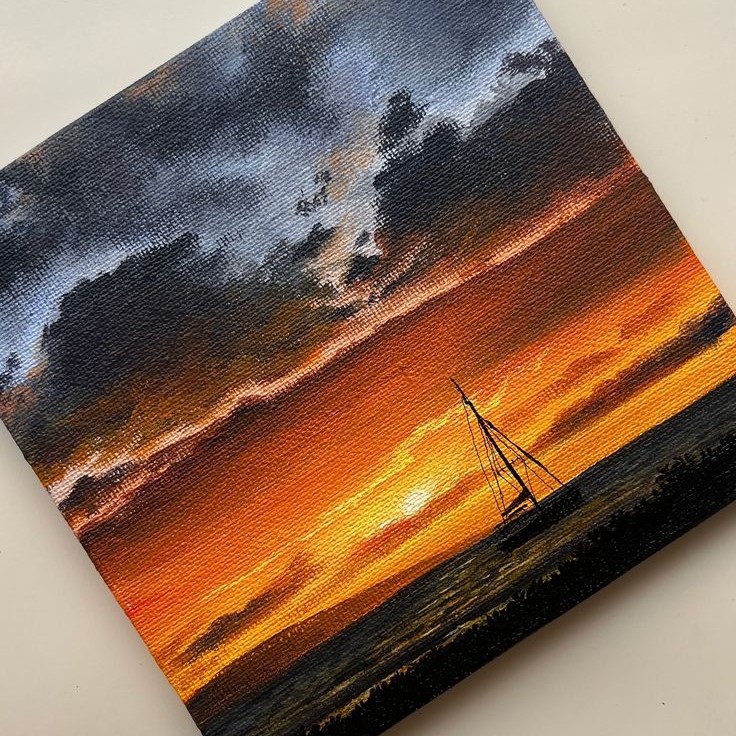
Conclusion
In conclusion, sunset canvas painting is a delightful way to express your artistic side while adding elegance to your home decor. By exploring different painting techniques and styles, you can create stunning sunset scenes that resonate with personal experiences and emotions.
From blending colors to incorporating silhouettes, the possibilities are endless. Whether you are a beginner or an experienced artist, these ideas can inspire you to create captivating artwork. So gather your supplies, unleash your creativity, and let the beauty of sunsets inspire your next masterpiece! Happy painting!